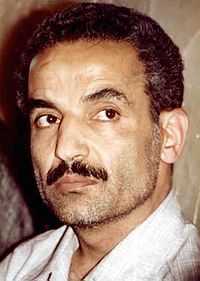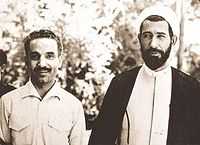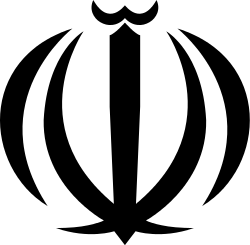Mohammad-Ali Rajai
| Mohammad-Ali Rajai | |
|---|---|
 | |
| 2nd President of Iran | |
| In office 2 August 1981 – 30 August 1981 | |
| Supreme Leader | Ruhollah Khomeini |
| Prime Minister | Mohammad-Javad Bahonar |
| Preceded by | Abolhassan Banisadr |
| Succeeded by | Ali Khamenei |
| Prime Minister of Iran | |
| In office 12 August 1980 – 4 August 1981 | |
| President | Abolhassan Banisadr |
| Preceded by | Mehdi Bazargan |
| Succeeded by | Mohammad Javad Bahonar |
| Minister of Foreign Affairs | |
| In office 11 March 1981 – 15 August 1981 | |
| President | Abolhassan Banisadr |
| Prime Minister | Himself |
| Preceded by | Karim Khodapanahi |
| Succeeded by | Mir-Hossein Mousavi |
| Personal details | |
| Born | 15 June 1933 Qazvin, Persia |
| Died | 30 August 1981 (aged 48) Tehran, Iran |
| Political party | Islamic Republic Party |
| Spouse(s) | Ateghe Sediqi (1958–1981) |
| Religion | Shia Islam |
Mohammad-Ali Rajai (Persian: محمدعلی رجائی; 15 June 1933 – 30 August 1981) was the president of Iran from 2 to 30 August 1981 after serving as prime minister under Abolhassan Banisadr. He was also minister of foreign affairs from 11 March 1981 to 15 August 1981, while he was prime minister. He was assassinated in a bombing on 30 August 1981 along with prime minister Mohammad-Javad Bahonar.
Early life and education
Mohammad-Ali Rajai was born on 15 June 1933 in Qazvin, Iran.[1] His father, Abdulsamad, died when he was 4 years old after which he lived with his mother and brother. Rajai grew up in Qazvin, and moved to Tehran in 1946. After moving to Tehran, he had a close relationship with the anti-Shah groups and parties. He known with Ayatollah Mahmoud Taleghani. In 1958, He moved to Bijar for a short period, but after a year, he moved back to Tehran and graduated with a degree in education from Tarbiat Moallem University in 1959. He became a member of the People's Mujahedin of Iran (MKO).[2] In 1960, he also joined Freedom Movement of Iran.[1][3] He was arrested by the Shah's forces for three times for his opposition activities.[3] He was lastly detained in May 1974, but was set free after four years.
He was actively involved in the Iranian Revolution and was a leader in the movement to purge Iranian universities of American and European influences, which was later called the Cultural Revolution.
Career
In 1979, Rajai left the Freedom Movement.[1] Following the Iranian Revolution, he was appointed minister of education in the government of Mehdi Bazargan, and although Bazargan's cabinet resigned on 6 November 1979, he did not resign and remained in the post until 12 August 1980 when he became prime minister. Following the presidency of Bani Sadr, after 5 months, he nominated Rajai for the position, and parliament voted him in. He appointed Khodapanahi as foreign minister, Mohammad-Reza Mahdavi Kani as interior minister and Javad Fakori as defence minister. During his prime ministership, Iran–Iraq War started and his government's first policy became the "victory and defense". He was in office until 2 August 1981 when he became the second president of Iran.
Banisadr was impeached on 22 June 1981 by parliament, and Khomeini held a Provisional Presidential Council by 6 people headed by Mohammad Beheshti and later Abdul-Karim Mousavi Ardebili. Rajai was one of the members of that Council. He nominated himself for the presidential election in 1981. He was the first president from the Islamic Republican Party after winning 91% of the votes. He officially became the president after Oath of Office in 2 August 1981.[4] He named Mohammad-Javad Bahonar to the Parliament to become the next prime minister. Parliament voted in to Bahonar and he formed a new government.
Assassination
On 30 August 1981, President Rajai held a meeting of Iran's Supreme Defense Council, along with the Prime Minister Mohammad Javad Bahonar. Witnesses later stated that a trusted aide brought a briefcase into the conference room, set it between the two leaders, and then left. Another person opened the case, triggering a bomb that set the room ablaze and killed Rajai, Bahonar, and three others.[5] The assassin was identified as Massoud Kashmiri, an operative of the People's Mujahedin of Iran (also known as the MKO, MEK and PMOI), who had infiltrated the Prime Minister's office in the guise of a state security official. Rajai was buried in Behesht-e Zahra.
-

Rajai and Ruhollah Khomeini
-

Rajai and Prime Minister Mohammad-Javad Bahonar
References
- ↑ 1.0 1.1 1.2 Houchang E. Chehabi (1990). Iranian Politics and Religious Modernism: The Liberation Movement of Iran Under the Shah and Khomeini. I.B.Tauris. p. 87. ISBN 978-1-85043-198-5. Retrieved 27 August 2013.
- ↑ Ostovar, Afshon P. (2009). "Guardians of the Islamic Revolution Ideology, Politics, and the Development of Military Power in Iran (1979–2009)" (PHD THESIS). University of Michigan. Retrieved 26 July 2013.
- ↑ 3.0 3.1 "Mohammad Ali Raja'i". Encyclopedia Britannica. Retrieved 27 August 2013.
- ↑ "Rajai Sworn In; Bani-Sadr Predicts Revolt", Pittsburgh Press, 2 August 1981, p. A-8
- ↑ Facts on File Yearbook 1981
| Political offices | ||
|---|---|---|
| Preceded by Mehdi Bazargan |
Prime Minister of Iran 1980–1981 |
Succeeded by Mohammad Javad Bahonar |
| Preceded by Karim Khodapanahi |
Minister of Foreign Affairs 1981 |
Succeeded by Mir-Hossein Mousavi |
| Preceded by Abulhassan Banisadr |
President of Iran 1981 |
Succeeded by Ali Khamenei |
| ||||||||
| ||||||||||||||
| ||||||||
| Wikimedia Commons has media related to Mohammad-Ali Rajai. |

.svg.png)